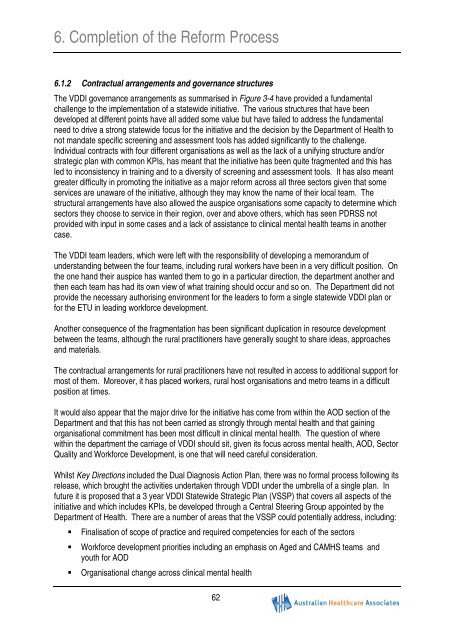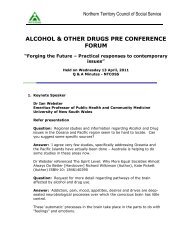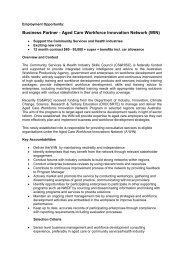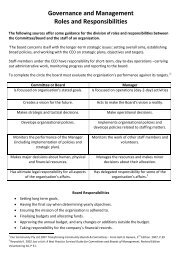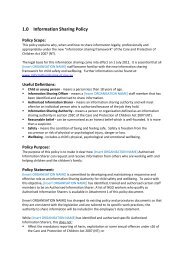(2011) Evaluation of the Victorian Dual Diagnosis Initiative
(2011) Evaluation of the Victorian Dual Diagnosis Initiative
(2011) Evaluation of the Victorian Dual Diagnosis Initiative
Create successful ePaper yourself
Turn your PDF publications into a flip-book with our unique Google optimized e-Paper software.
6. Completion <strong>of</strong> <strong>the</strong> Reform Process<br />
6.1.2 Contractual arrangements and governance structures<br />
The VDDI governance arrangements as summarised in Figure 3-4 have provided a fundamental<br />
challenge to <strong>the</strong> implementation <strong>of</strong> a statewide initiative. The various structures that have been<br />
developed at different points have all added some value but have failed to address <strong>the</strong> fundamental<br />
need to drive a strong statewide focus for <strong>the</strong> initiative and <strong>the</strong> decision by <strong>the</strong> Department <strong>of</strong> Health to<br />
not mandate specific screening and assessment tools has added significantly to <strong>the</strong> challenge.<br />
Individual contracts with four different organisations as well as <strong>the</strong> lack <strong>of</strong> a unifying structure and/or<br />
strategic plan with common KPIs, has meant that <strong>the</strong> initiative has been quite fragmented and this has<br />
led to inconsistency in training and to a diversity <strong>of</strong> screening and assessment tools. It has also meant<br />
greater difficulty in promoting <strong>the</strong> initiative as a major reform across all three sectors given that some<br />
services are unaware <strong>of</strong> <strong>the</strong> initiative, although <strong>the</strong>y may know <strong>the</strong> name <strong>of</strong> <strong>the</strong>ir local team. The<br />
structural arrangements have also allowed <strong>the</strong> auspice organisations some capacity to determine which<br />
sectors <strong>the</strong>y choose to service in <strong>the</strong>ir region, over and above o<strong>the</strong>rs, which has seen PDRSS not<br />
provided with input in some cases and a lack <strong>of</strong> assistance to clinical mental health teams in ano<strong>the</strong>r<br />
case.<br />
The VDDI team leaders, which were left with <strong>the</strong> responsibility <strong>of</strong> developing a memorandum <strong>of</strong><br />
understanding between <strong>the</strong> four teams, including rural workers have been in a very difficult position. On<br />
<strong>the</strong> one hand <strong>the</strong>ir auspice has wanted <strong>the</strong>m to go in a particular direction, <strong>the</strong> department ano<strong>the</strong>r and<br />
<strong>the</strong>n each team has had its own view <strong>of</strong> what training should occur and so on. The Department did not<br />
provide <strong>the</strong> necessary authorising environment for <strong>the</strong> leaders to form a single statewide VDDI plan or<br />
for <strong>the</strong> ETU in leading workforce development.<br />
Ano<strong>the</strong>r consequence <strong>of</strong> <strong>the</strong> fragmentation has been significant duplication in resource development<br />
between <strong>the</strong> teams, although <strong>the</strong> rural practitioners have generally sought to share ideas, approaches<br />
and materials.<br />
The contractual arrangements for rural practitioners have not resulted in access to additional support for<br />
most <strong>of</strong> <strong>the</strong>m. Moreover, it has placed workers, rural host organisations and metro teams in a difficult<br />
position at times.<br />
It would also appear that <strong>the</strong> major drive for <strong>the</strong> initiative has come from within <strong>the</strong> AOD section <strong>of</strong> <strong>the</strong><br />
Department and that this has not been carried as strongly through mental health and that gaining<br />
organisational commitment has been most difficult in clinical mental health. The question <strong>of</strong> where<br />
within <strong>the</strong> department <strong>the</strong> carriage <strong>of</strong> VDDI should sit, given its focus across mental health, AOD, Sector<br />
Quality and Workforce Development, is one that will need careful consideration.<br />
Whilst Key Directions included <strong>the</strong> <strong>Dual</strong> <strong>Diagnosis</strong> Action Plan, <strong>the</strong>re was no formal process following its<br />
release, which brought <strong>the</strong> activities undertaken through VDDI under <strong>the</strong> umbrella <strong>of</strong> a single plan. In<br />
future it is proposed that a 3 year VDDI Statewide Strategic Plan (VSSP) that covers all aspects <strong>of</strong> <strong>the</strong><br />
initiative and which includes KPIs, be developed through a Central Steering Group appointed by <strong>the</strong><br />
Department <strong>of</strong> Health. There are a number <strong>of</strong> areas that <strong>the</strong> VSSP could potentially address, including:<br />
• Finalisation <strong>of</strong> scope <strong>of</strong> practice and required competencies for each <strong>of</strong> <strong>the</strong> sectors<br />
• Workforce development priorities including an emphasis on Aged and CAMHS teams and<br />
youth for AOD<br />
• Organisational change across clinical mental health<br />
62


